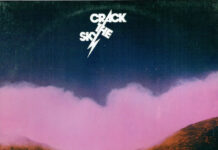The costumed antipope at the helm of the Swedish heavy-metal theatre, GHOST, jocularly referred to the band’s songs as “love songs for Satan,” once, and, of course, the religious fundamentals had a field day, immediately, entirely missing the joke. It’s funny that OPETH‘s 1995 debut never made such headlines even though the band’s dry-witted frontman, Mikael Åkerfeldt, has publicly dubbed the songs as being oaths to the Devil, more or less. Then again, OPETH‘s music is not exactly something of the sort that Stanford housewives would choose to put on for some extra fizz on a Sunday afternoon, the raw debut even less so. Released on May 15th, 1995, via Candlelight Records in Europe, “Orchid” is a 7-track excursion into the progressive extremes of the early-1990s death metal, stretching the boundaries a little bit further than their contemporaries in a genre that wasn’t exactly aversive to experimentation, to begin with. OPETH‘s style, already in the band’s embryonic stage, stood out from the typical death-metal bands of the era so much that the band got the recording deal from Candlelight even without the usual hassle of sending demos. These first seven songs form a rather audacious, stylistic statement, blending progressive rock and folk with the standard black and death metal aesthetic. Åkerfeldt himself later dubbed the debut as a hybrid of WISHBONE ASH, BLACK SABBATH, and BATHORY. The far-beyond-epic contrast between the delicate, acoustic sections and pounding brutality set the tone for quite a few OPETH albums to come, and it would later turn into one of the band’s most essential, if not trademark, quirks. Now, 30 years later, some of the album’s most Opethian moments still stand among their best work.

Of course, with the album being the band’s debut, it is not without its flaws; if you are a Johnny-come-lately in the parish of OPETH fanboys, like me, who got enchanted by the band’s later, more progressive finesse, the raw production might strike you as slightly off-putting. I mean, it is quite raw even compared to the death-metal framework of the era. It’s somewhat closer to the black-metal aesthetic. Then, the lengthier songs on the album are by far more disjointed than the band’s later prog epics – maybe some particular songs on “Heritage” (2011) notwithstanding. It is a feat that is not entirely without its peculiar appeal if you happened to grow up listening to those obscure prog and jazz-rock albums from the 1970s, but paired with such an abrasive, black-metal aesthetic, it might require some getting used to. In 1995, I was still going through my eclectic vintage-prog phase, so this album would have been a little too much to take, perhaps. In retrospect, it is easier to appreciate the band’s budding prog-metal genius. That said, the 2002 reissue of the album could have done without the bonus track, an early rehearsal-room demo of “Into the Frost of Winter,” which sounds exactly like having been recorded in a garage with a $10 microphone.
Still, despite the album’s obvious weaknesses, there are a good few tracks that not only stand out as pure, unpolished gems but also subtly hint at the band’s future greatness. While the debut is somewhat similar to the band’s sophomore album, “Morningrise” (1996), it is by far more melodic and infested with medieval-folkish passages, and what sets it apart from its successor as well as from most of its contemporaries is that dark and desolate, somewhat evil atmosphere! Some of the band’s best portfolio songs in this respect come from this very album, songs such as “In the Mist She Was Standing,” “Forest of October,” and “Under the Weeping Moon.” In my opinion, the band would not top this monument of darkness until their 2001 monolith, “Blackwater Park,” in terms of atmosphere. When it comes to riffs, this debut lacks coherence, but its atmosphere is something else entirely!
As far as the riffs go, “The Twilight Is My Robe” is worth mentioning as a rather good collection of banging riffs. Then, “The Apostle in Triumph” has a few good riffs and beautiful melodies on offer. As good as the riffs and melodic motifs are in themselves, however, some of them are arranged in a rather peculiar manner – a feature that would later surface on that controversial 2011 album by which the band took on a wild tangent into the murky depths of vintage prog. It is almost as if the songs were arranged by throwing in riffs and motifs at random, in a somewhat Musikalisches Würfelspiel-like fashion. It was a system for generating music throughout Western Europe in the 18th century by throwing dice, and some of those vintage prog outfits from the 1970s sure did sound as if they were fully aware of this technique.
In conclusion, OPETH‘s debut stands as a pioneering venture into deep, dark waters, and as such, it is a different beast from almost anything in their discography. It is not without its flaws, but it is a rather good, perhaps a little unpolished entry into the realm of progressive death metal. It seems to have remained one of the most overlooked albums to date in the band’s back catalog, but as its 30th anniversary is now upon us, why not give it a spin? It is a fine debut full of promise that the band most definitely made good upon later.
Written by Jani Lehtinen
Tracklist
- In Mist She Was Standing
- Under the Weeping Moon
- Silhouette (instrumental)
- Forest of October
- The Twilight Is My Robe
- Requiem (instrumental)
- The Apostle in Triumph
Lineup
Mikael Åkerfeldt – vocals, guitars
Peter Lindgren – guitars
Anders Nordin – drums, percussion, piano on “Silhouette”
Johan De Farfalla – bass, backing vocals
Label
Candlelight





